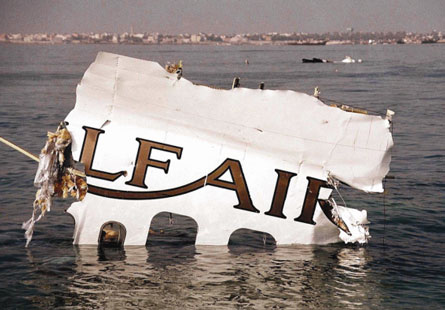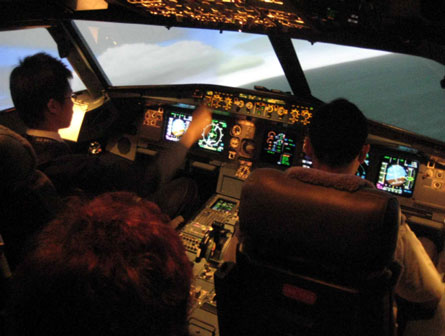The world's best consolidated airline pilot training courses produce, at graduation, young pilots with manual and mental flying skills that are probably as sharp as they will ever be.
But what then? The sharp young pilots will be working in today's ultra-reliable, highly automated aeroplanes, operating the same uneventful flight cycles every day - even if on different routes. Is it all downhill for their skills from that point onwards?
Line flying does not provide the on-the-job experience that flying in classic aircraft once did, so where is the stimulus going to come from to keep their skills up to scratch?
This is a question that needs answering, according to the UK Civil Aviation Authority's head of flight crew standards, David McCorquodale. So he and his team have set about researching whether degradation of crew skills is anecdotal or real, and the study is being driven by relentless evidence that quite a few crews worldwide have lost control of serviceable aircraft.
 |
|---|
© Rex Features This crash of a Gulf Air Airbus A320 in Bahrain in 2000 was attributed to loss of control |
There may only have been a few such events on a global statistical scale, but they have been regular, and since airline crashes of any kind are now very rare, the number of loss of control (LOC) accidents is significant within that total. There have been nine fatal LOC airline accidents since 2000, all of which were avoidable. But 1,128 people died in them.
LOC accidents were less common as a proportion of total airline mishaps 30 and more years ago, but now LOC has forced itself to the top of the CAA's "Significant Seven" aviation safety priorities list.
When pilots lose control of a serviceable aircraft, it is presumed to happen as a result of incorrect reactions to what they see - or what they think they see. As a result, the CAA has commissioned a study of what pilots monitor on the flightdeck, how they do it and how they react to what they perceive.
McCorquodale admits no-one is certain of all the factors that lead to LOC, but they suspect that the knock-on effects of high levels of automation play a part. The authority had set up the Loss of Control Task Force several years ago, which reported at the end of 2010. The new pilot monitoring study is a direct result of what the task force found.
MULTIPLE APPROACHES
Meanwhile, so as not to lose time while the monitoring study continues, training standards inspector Capt David Simmonds says all UK commercial pilots will in March receive a DVD demonstrating jet upset recovery techniques.
Understanding why pilots do what they do entails understanding how they gather their information before they make decisions, said McCorquodale: hence this "pilot monitoring research programme", which is being carried out for the CAA by consultancy ESE Associates.
McCorquodale says it is not only a matter of employing techniques such as eye-tracking to check instrument scan, but also an examination of pilot behaviour, how pilots monitor each other, what interaction the monitoring produces and whether it is effective.
The CAA has already drafted a summary of results from the first phase, which has been concerned with establishing facts. In the second and third stages, the agency will set about designing training aids - including videos - and finally an implementation plan, says McCorquodale.
The intention is to convey to pilots the facts about pilot monitoring best practice, as determined by analysis of the data extracted during the research.
Meanwhile, other issues are also under examination. The CAA accepts that pilots are not trained in the best use of automatic systems, and that the current statutory testing schedule that pilots undergo every six months during their recurrent training/checking is no longer appropriate for modern aircraft.
CAA training standards inspector Capt Andy Gaskell concedes not only that the recurrent simulator routine at airlines that have not adopted an approved alternate training qualification programme (ATQP) - most of them - is predictable for the pilots, but also that about 75% of the simulator time is spent on testing and only about 25% on training. This makes it a lost opportunity for raising standards. That balance should be reversed, he says.
There is a significant shift in the way new or revised regulations are being applied, says Gaskell, transferring to the airlines the responsibility for monitoring safety performance and for acting on the findings.
The regulators continue to exercise oversight through periodic checks, but now, with operational flight data monitoring (FDM) and safety management systems (SMSs) compulsory at airlines, the authorities will exercise their oversight differently.
Instead of inspecting directly for mistakes or omissions, they will inspect the airlines' FDM and SMSs to see if they are discovering their own mistakes and taking action to rectify them. "We are going to be digging to see what they are doing about what they find," says McCorquodale, adding wryly: "We have the data, so they can't hide."
Adopting an ATQP is seen by the CAA as an important part of the answer to improving the effectiveness of future pilot recurrent training. This is a tailored training programme that acknowledges what is unique about each airline - for example: the types it operates; the kind of flying it does (long/short haul, major hubs or regional airports, harsh/benign weather environment); and even where it hires its pilots from.
Training has to take into account the fact, for example, that an airline hires from a specific national or regional culture, or rosters a high proportion of multicultural crews. Each airline's plan for its ATQP has to be approved by the national aviation authority.
So far the CAA has approved ATQP at British Airways, EasyJet, Virgin Atlantic, Thomson Airways and Thomas Cook, but this is a relatively recent development and ATQP has hardly been adopted in continental Europe. So far the USA is the most enthusiastic applicant of the system.
Emirates rosters multicultural crews most of the time, and has a crew resource management training programme that acknowledges this fact and helps crew members to work together effectively, whatever their cultural history.
But special needs can show up at any time during a pilot's training, including the ab-initio phase. Anthony Petteford, Oxford Aviation Academy's head of ab-initio training at its base in Kidlington, UK, is currently training pilots for Hong Kong-based Dragonair under the multi-crew pilot license (MPL) system.
 |
|---|
MPL enables airlines to train pilots tailored to their aircraft types and their operations right from the start, so in a way the MPL course is the ab initio training equivalent of an ATQP |
The Hong Kong-born trainees need more time learning landing skills than usual, says Petteford, possibly because they are city-dwellers and are thus not accustomed to open spaces, high speeds and high spatial closing rates. So additional landings is what they get. It's the simple application of more time where it's needed, which is what ATQP is all about.
POSITIVE INDICATIONS
There is no question, according to McCorquodale, that those airlines and national aviation authorities that have used the MPL route for their pilot training have been "delighted" with the results.
While the CAA says it recognises that it is early days yet, and that it will be desirable to monitor the line flying performance of MPL graduates all the way through to command before they are able to deliver a final verdict, there is solid confidence in the quality of output according to all the evidence gathered so far.
MPL enables airlines to train pilots tailored to their aircraft types and their operations right from the start, so in a way the MPL course is the ab initio training equivalent of an ATQP.
Dragonair MPL graduates are bound for the right-hand seats of the airline's Airbus A330s as well as of its A320 fleet. If putting ab initio pilots straight into the right-hand seat of a widebody sounds like a first, it is not, says McCorquodale. Back in the 1970s, British Airways put ab initio graduates from its own Hamble training course straight into the right-hand seat of its Lockheed TriStars.
There is an emerging consistency in the views of those who embrace the human output of high quality consolidated ab initio training, whether the graduates follow the MPL or traditional commercial pilot licence (CPL) route.
This, the argument runs, is more likely to provide a robust product than the modular approach involving hours-building in bush flying, agricultural work, instructional flying or other methods of accumulating time in the air.
While this system might produce a well-rounded aviator, equally it might not. It is rather hit-and-miss and, as Petteford says, just as likely to permit the development of bad habits as it is to produce useful and beneficial experience.
JET ORIENTATION
This issue of training completeness and discipline compared with randomness and relatively unsupervised development is one of the issues the LOC Task Force dealt with in its recommendations.
Here is one of the recommendations: "Mandate a jet orientation course for all pilots who do not complete an MPL course. They must complete a JOC [jet orientation course] before presenting for their first type rating on a complex and highly automated type."
The reason for this, says McCorquodale, is that many student pilots have serious problems facing their first type rating on a modern, complex jet. An MPL prepares the student for precisely this challenge, whereas the modular route, depending on what experience the pilot achieves during it, may provide little or no experience of jets and the speed at which things happen in them, or of managing sophisticated flight management and aircraft control systems, and it is in these aircraft that LOC events have been occurring.
Of course updating out-of-date recurrent training requirements is not an issue for the CAA alone, although national authorities have some latitude in how they apply International Civil Aviation Organisation training standards and recommended practices locally.
McCorquodale says the CAA "has taken pains to get involved in both ICAO and European Aviation Safety Agency rulemaking subcommittees" and believes it can help influence positively the way training regulation is being written.
The CAA believes it can help influence positively the way training regulation is written
Source: Flight International


























